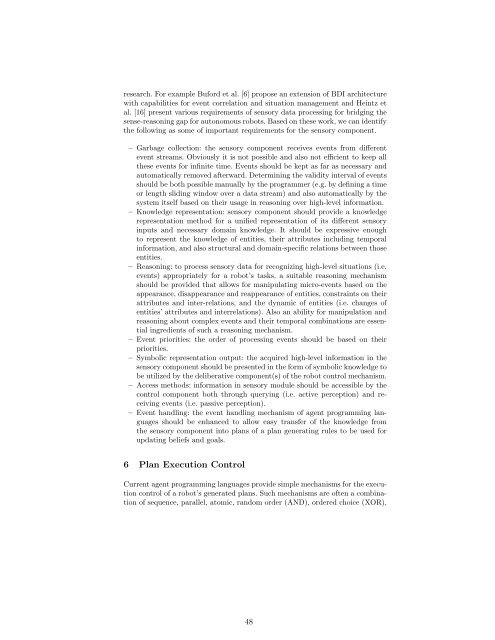Here - Agents Lab - University of Nottingham
Here - Agents Lab - University of Nottingham
Here - Agents Lab - University of Nottingham
You also want an ePaper? Increase the reach of your titles
YUMPU automatically turns print PDFs into web optimized ePapers that Google loves.
esearch. For example Buford et al. [6] propose an extension <strong>of</strong> BDI architecturewith capabilities for event correlation and situation management and Heintz etal. [16] present various requirements <strong>of</strong> sensory data processing for bridging thesense-reasoning gap for autonomous robots. Based on these work, we can identifythe following as some <strong>of</strong> important requirements for the sensory component.– Garbage collection: the sensory component receives events from differentevent streams. Obviously it is not possible and also not efficient to keep allthese events for infinite time. Events should be kept as far as necessary andautomatically removed afterward. Determining the validity interval <strong>of</strong> eventsshould be both possible manually by the programmer (e.g. by defining a timeor length sliding window over a data stream) and also automatically by thesystem itself based on their usage in reasoning over high-level information.– Knowledge representation: sensory component should provide a knowledgerepresentation method for a unified representation <strong>of</strong> its different sensoryinputs and necessary domain knowledge. It should be expressive enoughto represent the knowledge <strong>of</strong> entities, their attributes including temporalinformation, and also structural and domain-specific relations between thoseentities.– Reasoning: to process sensory data for recognizing high-level situations (i.e.events) appropriately for a robot’s tasks, a suitable reasoning mechanismshould be provided that allows for manipulating micro-events based on theappearance, disappearance and reappearance <strong>of</strong> entities, constraints on theirattributes and inter-relations, and the dynamic <strong>of</strong> entities (i.e. changes <strong>of</strong>entities’ attributes and interrelations). Also an ability for manipulation andreasoning about complex events and their temporal combinations are essentialingredients <strong>of</strong> such a reasoning mechanism.– Event priorities: the order <strong>of</strong> processing events should be based on theirpriorities.– Symbolic representation output: the acquired high-level information in thesensory component should be presented in the form <strong>of</strong> symbolic knowledge tobe utilized by the deliberative component(s) <strong>of</strong> the robot control mechanism.– Access methods: information in sensory module should be accessible by thecontrol component both through querying (i.e. active perception) and receivingevents (i.e. passive perception).– Event handling: the event handling mechanism <strong>of</strong> agent programming languagesshould be enhanced to allow easy transfer <strong>of</strong> the knowledge fromthe sensory component into plans <strong>of</strong> a plan generating rules to be used forupdating beliefs and goals.6 Plan Execution ControlCurrent agent programming languages provide simple mechanisms for the executioncontrol <strong>of</strong> a robot’s generated plans. Such mechanisms are <strong>of</strong>ten a combination<strong>of</strong> sequence, parallel, atomic, random order (AND), ordered choice (XOR),48


